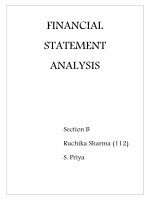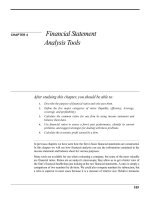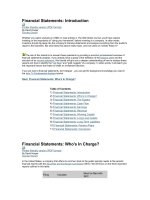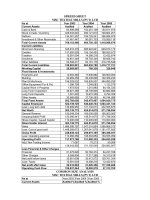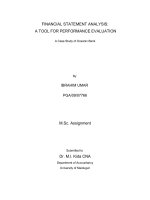FINANCIAL STATEMENT ANALYSIS MOCK EXAM
Bạn đang xem bản rút gọn của tài liệu. Xem và tải ngay bản đầy đủ của tài liệu tại đây (655.73 KB, 10 trang )
FINANCIAL STATEMENT ANALYSIS MOCK EXAM
I.
MULTIPLE CHOICE
The following information is relevant for Questions 1 and 2:
Austin Corporation’s Year 8 financial statement notes include the following information:
a. Austin recently entered into operating leases with total future payments of $40 million that
equal a discounted present value of $20 million.
b. Long-term assets include held-to-maturity debt securities carried at their amortized cost of
$10 million. Fair market value of these securities is $12 million.
c. Austin guarantees a $5 million bond issue, due in Year 13. The bonds are issued by Healey,
a nonconsolidated 30%-owned affiliate.
After analysis, you decide to adjust Austin’s balance sheet for each of the above three items.
2. Among the effects of these adjustments for the long-term debt to equity ratio is:
A. Only the held-to-maturity debt securities adjustment decreases this ratio.
B. Only lease capitalization decreases this ratio.
C. All three adjustments decrease this ratio.
D. All three adjustments increase this ratio.
3. What is the effect of a cash dividend payment on the following ratios (all else equal)?
4. What is the effect of selling inventory for profit on the following ratios (all else equal)?
5. The existence of uncapitalized operating leases is to (choose one of the following):
A. Overstate the earnings to fixed charges coverage ratio.
B. Overstate fixed charges.
C. Overstate working capital.
D. Understate the long-term debt to equity ratio.
6. Which is least likely one of the conclusions about the impact of a change in
financial reporting standards that might appear in management’s discussion and
analysis?
A. Management has chosen not to implement the new standard.
B. Management is currently evaluating the impact of the new standard.
C. The new standard will not have a material impact on the company’s
financial statements.
7. A manufacturing firm sells a large amount of precision parts and provides
financing to the buyer at its usual credit terms. The firm should recognize
revenue from this transaction:
A. at the time of the sale.
B. using the installment method.
C. proportionally as payments are received.
8. Which of the following best describes the impact of depreciating equipment with
a useful life of 6 years using the declining balance method as compared to the
straight-line method?
A. Total depreciation expense will be higher over the life of the equipment.
B. Depreciation expense will be higher in the first year.
C. Scrapping the equipment after five years will result in a larger loss.
9. Which of the following is least likely to be included when calculating
comprehensive income?
A. Unrealized loss from cash flow hedging derivatives.
B. Unrealized gain from available-for-sale securities.
C. Dividends paid to common shareholders.
A company’s quick ratio is 1.2. If inventory were purchased for cash, the:
A. numerator would decrease more than the denominator, resulting in a lower quick ratio.
B. denominator would decrease more than the numerator, resulting in a higher current ratio.
C. numerator and denominator would decrease proportionally, leaving the current ratio
unchanged.
10. According to the IASB Conceptual Framework, the fundamental qualitative
characteristics that make financial statements useful are:
A. verifiability and timeliness.
B. relevance and faithful representation.
C. understandability and relevance.
11. Which of the following is most likely included in a firm’s ending inventory?
A. Storage costs of finished goods.
B. Variable production overhead.
C. Selling and administrative costs.
12. In periods of rising prices and stable inventory quantities, which of the following
best describes the effect on gross profit of using LIFO as compared to using FIFO?
A. Lower.
B. Higher.
C. The same.
13. A firm that uses LIFO for inventory accounting reported COGS of $300,000 and ending
inventory of $200,000 for the current period, and a LIFO reserve that decreased from
$40,000 to $35,000 over the period. If the firm had reported using FIFO, its gross profit
would have been:
A. the same.
B. $5,000 higher.
C. $5,000 lower.
14. During a period of increasing prices, compared to reporting under LIFO, a firm
that reports using average cost for inventory will have a:
A. lower gross margin.
B. higher current ratio.
C. higher asset turnover.
15. Red Company immediately expenses its development costs while Black Company
capitalizes its development costs. All else equal, Red Company will:
A. show smoother reported earnings than Black Company.
B. report higher operating cash flow than Black Company.
C. report higher asset turnover than Black Company.
16. Which of the following statements about indefinite-lived intangible assets is most
accurate?
A. They are amortized on a straight-line basis over a period not to exceed 40
years.
B. They are reported on the balance sheet indefinitely.
C. They never appear on the balance sheet unless they are internally
developed.
17. The author of a new textbook received a $100,000 advance from the publisher
this year. $40,000 of income taxes were paid on the advance when received. The
textbook will not be finished until next year. Determine the tax basis of the
advance at the end of this year.
A. $0.
B. $40,000.
C. $100,000.
KLH Company reported the following:
Gross DTA at the beginning of the year $10,500
Gross DTA at the end of the year $11,250
Valuation allowance at the beginning of the year $2,700
Valuation allowance at the end of the year $3,900
18. Which of the following statements best describes the expected earnings of the
firm? Earnings are expected to:
A. increase.
B. decrease.
C. remain relatively stable.
19. Which one of the following statements is most accurate? Under the liability
method of accounting for deferred taxes, a decrease in the tax rate at the
beginning of the accounting period will:
A. increase taxable income in the current period.
B. increase a deferred tax asset.
C. reduce a deferred tax liability.
20. A U.S. GAAP reporting firm reports an increased valuation allowance at the end of
the current period. What effect will this have on the firm’s income tax expense in
the current period?
A. Increase.
B. Decrease.
C. No effect.
21. For analytical purposes, what is the impact on the debt-to-equity ratio if the
market rate of interest increases after the bond is issued?
A. An increase.
B. A decrease.
C. No change.
22. How should an analyst most appropriately adjust the financial statements of a
firm that uses operating leases to finance its plant and equipment?
A. Increase liabilities.
B. Decrease long-lived assets.
C. Decrease shareholders’ equity.
23. A decrease in a firm’s inventory turnover ratio is most likely to result from:
A. a write-down of inventory.
B. goods in inventory becoming obsolete.
C. decreasing purchases in a period of stable sales.
24. If a firm’s management wishes to use its discretion to increase operating cash
flows, it is most likely to:
A. capitalize an expense.
B. decrease the allowance for uncollectible accounts.
C. change delivery terms from FOB destination to FOB shipping point.
25. Which of the following situations best correspond with a ratio of “sales to average net
tangible assets” exceeding the industry norm? (Choose one answer.)
a. A company expanding plant and equipment during the past three years.
b. A company inefficiently using its assets.
c. A company with a large proportion of aged plant and equipment
26. A measure of asset utilization (turnover) is (choose one answer):
a. Sales divided by average long-term operating assets.
b. Return on net operating assets
c. Return on common equity.
d. NOPAT divided by sales.
27. Return on net operating assets depends on the (choose one answer):
a. Interest rates and pretax profits.
c. After-tax operating profit margin and NOA turnover.
b. Debt to equity ratio.
d. Sales and total assets
II.
WRITTEN QUESTIONS
1. (1 mark) A colleague who is aware of your understanding of financial statements asks for
help in analyzing the transactions and events of Zett Corporation. The following data are
provided:
Additional data for the period January 1, Year 2, through December 31, Year 2, are:
1. Sales on account, $70,000.
2. Purchases on account, $40,000.
3. Depreciation, $5,000.
4. Expenses paid in cash, $18,000 (including $4,000 of interest and $6,000 in taxes).
5. Decrease in inventory, $2,000.
6. Sales of fixed assets for $6,000 cash; cost $21,000 and two-thirds depreciated (loss or gain
is included in
income).
7. Purchase of fixed assets for cash, $4,000.
8. Fixed assets are exchanged for bonds payable of $30,000.
9. Sale of investments for $9,000 cash.
10. Purchase of treasury stock for cash, $11,500.
11. Retire bonds payable by issuing common stock, $10,000.
12. Collections on accounts receivable, $65,000.
13. Sold unissued common stock for cash, $1,000.
Required:
Prepare a statement of cash flows (indirect method) for the year ended December 31, Year 2
and comment on the firm using cash flow analysis approach.
2. (1 marks) Comparative income statements of Spyres Manufacturing Company for Years 9
and 8 are reproduced below:
Required:
a). Prepare common size statements showing the percent of each item to net sales for both
Year 8 and Year 9. Include a column reporting the percentage increase or decrease for Year 9
relative to Year 8 (round numbers to the tenth of 1%).
b). Interpret the trend shown in your percentage calculations of a. What areas identified from
this analysis should be a matter of managerial concern.
4. (1 mark) Selected income statement and balance sheet data from Merck & Co. for Year 9
are reproduced below:
Required:
a. Calculate return on common equity for Year 9 using year-end amounts and assuming no
preferred dividends.
b. Disaggregate Merck’s ROCE into operating (RNOA) and nonoperating components.
Comment on Merck’s use of leverage. (Assume all assets and current liabilities are operating
and a 35% tax rate.)
5. (1 mark)
a. RAM is considering changing its credit policy. This change implies ending accounts
receivable would represent 90 days of sales. What is the impact of this policy change on
RAM’s current cash position? Will the company be required to borrow?
b. RAM is considering a change to a 120-day collection period based on ending accounts
receivable. What is the effect(s) of this change on its cash position?
c. Suppliers are considering changing their policy of extending credit to RAM to require
payment on purchases within 60 days; there would be no change in RAM’s collection period.
What is the effect(s) of this change on its cash position?




